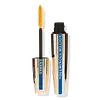Benefit Cosmetics BADgal BANG! Volumizing Mascara Versus L'Oreal Voluminous Million Lashes Waterproof Mascara
What's inside
What's inside
 Key Ingredients
Key Ingredients

 Benefits
Benefits

 Concerns
Concerns

 Ingredients Side-by-side
Ingredients Side-by-side

Water
Skin ConditioningParaffin
PerfumingCera Alba
EmollientGlyceryl Stearate
EmollientButylene Glycol
HumectantAcrylates Copolymer
Euphorbia Cerifera Wax
Copernicia Cerifera Wax
Polybutene
Steareth-21
CleansingVp/Eicosene Copolymer
Palmitic Acid
EmollientStearic Acid
CleansingPhenoxyethanol
PreservativeSteareth-2
EmulsifyingAminomethyl Propanediol
BufferingPanthenol
Skin ConditioningCaprylyl Glycol
EmollientHydroxyethylcellulose
Emulsion StabilisingSilica Silylate
EmollientTocopheryl Acetate
AntioxidantNylon-12
BHT
AntioxidantCI 19140
Cosmetic ColorantCI 42090
Cosmetic ColorantCI 77007
Cosmetic ColorantCI 77163
Cosmetic ColorantCI 77288
Cosmetic ColorantCI 77289
Cosmetic ColorantCI 77491
Cosmetic ColorantCI 77492
Cosmetic ColorantCI 77499
Cosmetic ColorantCI 77510
Cosmetic ColorantCI 77742
Cosmetic ColorantCI 77891
Cosmetic ColorantWater, Paraffin, Cera Alba, Glyceryl Stearate, Butylene Glycol, Acrylates Copolymer, Euphorbia Cerifera Wax, Copernicia Cerifera Wax, Polybutene, Steareth-21, Vp/Eicosene Copolymer, Palmitic Acid, Stearic Acid, Phenoxyethanol, Steareth-2, Aminomethyl Propanediol, Panthenol, Caprylyl Glycol, Hydroxyethylcellulose, Silica Silylate, Tocopheryl Acetate, Nylon-12, BHT, CI 19140, CI 42090, CI 77007, CI 77163, CI 77288, CI 77289, CI 77491, CI 77492, CI 77499, CI 77510, CI 77742, CI 77891
Water
Skin ConditioningParaffin
PerfumingPotassium Cetyl Phosphate
EmulsifyingAcrylates Copolymer
Cera Alba
EmollientCopernicia Cerifera Cera
EmollientSteareth-2
EmulsifyingCetyl Alcohol
EmollientPropylene Glycol
HumectantPhenoxyethanol
PreservativeHydroxyethylcellulose
Emulsion StabilisingAcacia Senegal Gum
MaskingEthylenediamine/Stearyl Dimer Dilinoleate Copolymer
Skin ConditioningMethylparaben
PreservativeSodium Dehydroacetate
PreservativeHydrogenated Jojoba Oil
AbrasiveHydrogenated Palm Oil
EmollientDisodium EDTA
Pentaerythrityl Tetraisostearate
EmollientEthylparaben
PreservativePvp
Emulsion StabilisingSodium Hyaluronate
Humectant2-Oleamido-1,3-Octadecanediol
Skin ConditioningPanthenol
Skin ConditioningSoluble Collagen
HumectantSilica Dimethyl Silylate
EmollientSodium Chondroitin Sulfate
Skin ConditioningAtelocollagen
Skin ConditioningCI 77266
Cosmetic ColorantWater, Paraffin, Potassium Cetyl Phosphate, Acrylates Copolymer, Cera Alba, Copernicia Cerifera Cera, Steareth-2, Cetyl Alcohol, Propylene Glycol, Phenoxyethanol, Hydroxyethylcellulose, Acacia Senegal Gum, Ethylenediamine/Stearyl Dimer Dilinoleate Copolymer, Methylparaben, Sodium Dehydroacetate, Hydrogenated Jojoba Oil, Hydrogenated Palm Oil, Disodium EDTA, Pentaerythrityl Tetraisostearate, Ethylparaben, Pvp, Sodium Hyaluronate, 2-Oleamido-1,3-Octadecanediol, Panthenol, Soluble Collagen, Silica Dimethyl Silylate, Sodium Chondroitin Sulfate, Atelocollagen, CI 77266
 Reviews
Reviews

Ingredients Explained
These ingredients are found in both products.
Ingredients higher up in an ingredient list are typically present in a larger amount.
Acrylates Copolymer is used as a film-forming agent and texture enhancer.
After applied, Acrylates Copolymer forms a thin film cover that helps skin feel more soft. It can help sunscreens become more water-resistant.
It is also used to make a product more thick.
Learn more about Acrylates CopolymerCera alba is beeswax, or the wax used by bees to make honeycombs. It is a texture-enhancer and emollient. A study from 2003 found beeswax to be a stronger emollient than ingredients such as petroleum jelly.
As an emollient, beeswax helps hydrate the skin by creating a barrier on top. This barrier traps moisture in.
Emulsifiers help prevent ingredients from separating. This helps create consistent texture.
The structure of beeswax is mainly long-chain alcohols and the esters of fatty acids.
There are three types of beeswax: yellow, white, and absolute. Yellow is pure beeswax taken from the honeycomb. White beeswax is created by filtering or bleaching yellow beeswax. Absolute beeswax is created by treating beeswax with alcohol. Beeswax used in cosmetics are purified.
Beeswax has been used throughout history and even in prehistoric times. Some common uses for beeswax still used today are making candles, as a waterproofing agent, and polish for leather.
Learn more about Cera AlbaHydroxyethylcellulose is used to improve the texture of products. It is created from a chemical reaction involving ethylene oxide and alkali-cellulose. Cellulose is a sugar found in plant cell walls and help give plants structure.
This ingredient helps stabilize products by preventing ingredients from separating. It can also help thicken the texture of a product.
This ingredient can also be found in pill medicines to help our bodies digest other ingredients.
Learn more about HydroxyethylcellulosePanthenol is a common ingredient that helps hydrate and soothe the skin. It is found naturally in our skin and hair.
There are two forms of panthenol: D and L.
D-panthenol is also known as dexpanthenol. Most cosmetics use dexpanthenol or a mixture of D and L-panthenol.
Panthenol is famous due to its ability to go deeper into the skin's layers. Using this ingredient has numerous pros (and no cons):
Like hyaluronic acid, panthenol is a humectant. Humectants are able to bind and hold large amounts of water to keep skin hydrated.
This ingredient works well for wound healing. It works by increasing tissue in the wound and helps close open wounds.
Once oxidized, panthenol converts to pantothenic acid. Panthothenic acid is found in all living cells.
This ingredient is also referred to as pro-vitamin B5.
Learn more about PanthenolParaffin is a solid created from petroleum. The term 'paraffin' can also refer to either
petroleum jelly or mineral oil.
It has natural occlusive properties which can worsen oily skin. Due to its petrolatum base, this ingredient is not fungal-acne safe.
Phenoxyethanol is a preservative that has germicide, antimicrobial, and aromatic properties. Studies show that phenoxyethanol can prevent microbial growth. By itself, it has a scent that is similar to that of a rose.
It's often used in formulations along with Caprylyl Glycol to preserve the shelf life of products.
Steareth-2 is a waxy compound used to emulsify ingredients. It is created from polyethylene glycol and stearyl alcohol.
The 2 stands for the number of ethylene oxide units used to create this ingredient.
Water. It's the most common cosmetic ingredient of all. You'll usually see it at the top of ingredient lists, meaning that it makes up the largest part of the product.
So why is it so popular? Water most often acts as a solvent - this means that it helps dissolve other ingredients into the formulation.
You'll also recognize water as that liquid we all need to stay alive. If you see this, drink a glass of water. Stay hydrated!
Learn more about Water